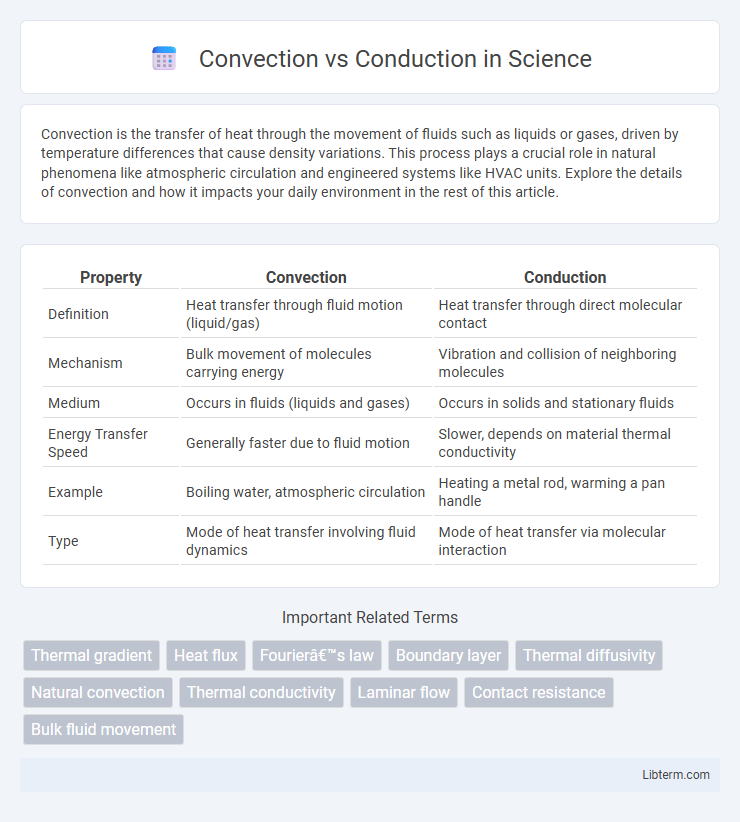Convection is the transfer of heat through the movement of fluids such as liquids or gases, driven by temperature differences that cause density variations. This process plays a crucial role in natural phenomena like atmospheric circulation and engineered systems like HVAC units. Explore the details of convection and how it impacts your daily environment in the rest of this article.
Table of Comparison
| Property | Convection | Conduction |
|---|---|---|
| Definition | Heat transfer through fluid motion (liquid/gas) | Heat transfer through direct molecular contact |
| Mechanism | Bulk movement of molecules carrying energy | Vibration and collision of neighboring molecules |
| Medium | Occurs in fluids (liquids and gases) | Occurs in solids and stationary fluids |
| Energy Transfer Speed | Generally faster due to fluid motion | Slower, depends on material thermal conductivity |
| Example | Boiling water, atmospheric circulation | Heating a metal rod, warming a pan handle |
| Type | Mode of heat transfer involving fluid dynamics | Mode of heat transfer via molecular interaction |
Understanding Heat Transfer: Convection and Conduction
Heat transfer occurs through conduction by direct molecular collision within solids, where thermal energy moves from high to low temperature regions without the bulk movement of the material. Convection involves the transfer of heat through the movement of fluids such as liquids or gases, driven by temperature-induced density differences that create fluid motion. Understanding the distinction between conduction's reliance on molecular interaction and convection's dependence on fluid flow is essential for optimizing thermal management in engineering and environmental processes.
What Is Conduction?
Conduction is the process of heat transfer through direct molecular collision within a solid or between solids in contact, where thermal energy moves from high to low temperature regions. This mode of heat transfer depends on the material's thermal conductivity, with metals like copper and aluminum exhibiting high conduction rates due to free electrons facilitating energy flow. Understanding conduction is crucial for applications involving heat sinks, insulation, and temperature regulation in engineering and everyday devices.
What Is Convection?
Convection is the transfer of heat through the movement of fluids, such as liquids or gases, caused by temperature differences within the fluid. It occurs when warmer, less dense fluid rises while cooler, denser fluid sinks, creating a continuous circulation pattern that distributes heat. This process is crucial in atmospheric phenomena, ocean currents, and heating systems, distinguishing it from conduction, which involves direct heat transfer through solid materials.
Key Differences Between Convection and Conduction
Convection transfers heat through fluid motion, involving the movement of liquids or gases, while conduction occurs via direct molecular collisions within solid materials. Conduction is governed by Fourier's law, emphasizing temperature gradients, whereas convection relies on fluid dynamics and buoyancy forces. The efficiency of convection depends on fluid velocity and properties, whereas conduction depends on thermal conductivity and material thickness.
Examples of Conduction in Everyday Life
Cooking on a stovetop exemplifies conduction, where heat transfers directly from the burner to the pot and then to the food. Holding a metal spoon in a hot cup of coffee demonstrates heat conduction through the spoon to the hand. Ironing clothes uses conduction as the heated iron plate directly transfers heat to smooth fabric fibers.
Examples of Convection in Everyday Life
Boiling water on a stove demonstrates convection as hot water rises and cooler water sinks, creating a circular motion. Warm air rising from a heater and cool air descending near the floor illustrates convection currents in a room. Ocean currents and weather patterns also rely on convection to distribute heat across the Earth's surface.
Factors Affecting Conduction
Conduction efficiency depends primarily on the thermal conductivity of the material, with metals like copper exhibiting high conductivity due to free electron movement. Temperature gradient significantly influences the heat transfer rate, as conduction occurs from higher to lower temperature regions. Material thickness and cross-sectional area also affect conduction, where thinner and wider materials facilitate faster heat flow.
Factors Influencing Convection
Temperature difference, fluid properties such as viscosity and thermal conductivity, and flow velocity are key factors influencing convection heat transfer. The nature of the fluid, whether it is a gas or liquid, affects the convection rate due to differences in density and specific heat capacity. Surface geometry and the presence of turbulence also play critical roles in enhancing or inhibiting convection efficiency.
Applications of Convection and Conduction
Conduction is widely applied in heat sinks and cooking utensils where direct heat transfer through solid materials is essential for efficient performance. Convection plays a crucial role in HVAC systems, weather patterns, and industrial processes by facilitating heat transfer through fluid movement. Understanding the specific applications of conduction and convection enhances energy efficiency and optimizes design in thermal management solutions.
Choosing Between Convection and Conduction in Practical Scenarios
Choosing between convection and conduction depends on the heat transfer medium and application requirements. Conduction is ideal for solid materials where direct molecular contact facilitates heat flow, such as in metal cookware or heat sinks. Convection suits fluid environments, enhancing heat transfer through fluid motion in systems like HVAC, boiling water, or cooling liquids.
Convection Infographic

 libterm.com
libterm.com